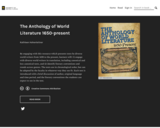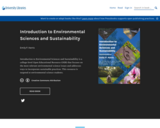
Learn flat pattern techniques as they apply to the design of 20th century clothing.
- Subject:
- Arts and Humanities
- Visual Arts
- Material Type:
- Textbook
- Provider:
- University of Florida Pressbooks
- Author:
- Jennifer K. Smith
- Date Added:
- 07/23/2020

Learn flat pattern techniques as they apply to the design of 20th century clothing.

Government can be defined as the institutions and processes that make and implement a society’s legally authoritative decisions. The government unit can be a city, a school board, a county, a state, a multi-state regional compact, a national government, or even an international body. In the U.S., government includes the national government institutions—Congress, the presidency, the federal courts, and the federal bureaucracies; the 50 state governments—state legislatures, governors, courts, and bureaucracies; and the thousands of local governments—cities, counties, and other special government districts such as school boards and the transportation authorities that govern airports, seaports, and mass transit. These governments make legally authoritative decisions that include legislation, administrative regulations, executive orders, case law rulings, and other public policy actions that are authoritative because individuals and organizations are obligated to obey them or face some kind of legal sanction.

Contents include:
1. Why Government? Why Politics? 2. The U.S. System of Constitutional Government 3. Congress 4. The Presidency 5. The Judiciary 6. Federalism 7. The Media, Government, and Politics 8. Public Opinion 9. Political Ideology 10. Political Participation 11. Political Parties 12. Interest Groups 13. Public Policy 14. Economic Policy 15. Food Policy 16. Crime Policy 17. Global Affairs 18. Civil Liberties and Civil Rights

This is an anthology of Medieval Literature.

By engaging with this resource which presents texts by diverse world writers from 1650 to the present, learners will: (1) engage with diverse world writers in translation, including canonical and less canonical texts, and (2) identify literary conventions and trends across genres. The texts are in chronological order, but can be adapted by the faculty in whatever way they see fit. Each text is introduced with a brief discussion of author, original language and time period, and the literary conventions the students can expect to see in the text.

Using natural sensory system concepts to develop and improve sensory systems will continue to thrive for many years to come. Technology advances rapidly (Moore’s Law) as does our understanding of biological principles and designs. These trends fuel the fertile grounds of bio-inspired sensory systems, a topic that is inherently multidisciplinary. This book will serve well as either an academic text on the subject or an introduction to the variety of proven bio-inspired designs. The focus is on sensory systems that interpret environmental stimuli. It introduces natural photo-, mechano-, and chemo-sensory systems across the animal kingdom and also summarizes various novel engineering ideas that glean ideas from these natural sensory systems.

In the realm of human interactions, conflict is an inevitable facet, yet many lack adept strategies to maneuver through workplace disputes. This book offers fundamental strategies and frameworks, aiming to empower individuals to transform conflicts into opportunities. By embracing these insights, readers can foster stronger relationships, turning adversarial situations into catalysts for personal and professional growth.

Career Cornerstones: Establishing a Foundation for a Career in Healthcare is an Open Educational Resource (OER) that focuses on career skills required for students entering their respective health profession's program. This book is designed to help students be successful not only in their health profession's educational program, but also as they start to intern or work in healthcare settings. This resource is targeted for Healthcare Administration, Health Sciences, and Pre-Professional students.

Welcome to Charting Your Course: A Roadmap to Thriving in the Field of Health! Whether you are in your first semester, nearing graduation, or long past graduation, this career guide is designed to lead you through the career development process: from building self-awareness, to conducting career research, undertaking a job search, to succeeding on the job. Charting Your Course includes relevant, up-to-date information, interactive and self-reflection-based exercises, as well as online resources to help support you to become more comfortable, flexible, and adept at managing your career.

Clipart images that relate to probability.

From the University of Florida Department of Mathematics, this is the second volume in a three volume presentation of calculus from a concepts perspective. The emphasis is on learning the concepts behind the theories, not the rote completion of problems.

This book describes elementary science content aligned with the Florida Teacher Certification Examination (FTCE) K-6 competencies and skills.

Developmental Dyscalculia (DD) is a learning disorder affecting the ability to acquire school-level
arithmetic skills, affecting approximately 3-6% of individuals. Progress in understanding the root causes
of DD and how best to treat it have been impeded by lack of widespread research and variation in
characterizations of the disorder across studies. However, recent years have witnessed significant growth
in the field, and a growing body of behavioral and neuroimaging evidence now points to an underlying
deficit in the representation and processing of numerical magnitude information as a potential core
deficit in DD. An additional product of the recent progress in understanding DD is the resurgence of a
distinction between ‘primary’ and ‘secondary’ developmental dyscalculia. The first appears related to
impaired development of brain mechanisms for processing numerical magnitude information, while the
latter refers to mathematical deficits stemming from external factors such as poor teaching, low socioeconomic status, and behavioral attention problems or domain-general cognitive deficits. Increased
awareness of this distinction going forward, in combination with longitudinal empirical research, offers
great potential for deepening our understanding of the disorder and developing effective educational
interventions.

Welcome to Exploring the U.S. Healthcare System. This open educational resource (OER) introduces students to foundational characteristics of the U.S. healthcare system. It begins with an overview of the healthcare system that includes a brief history and a description of the current state of health in the U.S. The second chapter describes health delivery systems, including inpatient, outpatient, post-acute, long-term, palliative, and hospice care. An introduction to health insurance in the third chapter will include an overview of basic concepts, private insurance, public insurance, and recent trends. The fourth chapter presents issues related to the triple aim of improving access to care, increasing the quality of care, and lowering the cost of care. The fifth chapter reviews how the government intervenes in healthcare and presents current policy issues related to the Patient Protection and Affordable Care Act and value-based contracting. The final chapter on the topic of technology in healthcare provides an overview of health information technology, health information legislation, emerging technologies, and the future of health information technology.

Ready to find out how plants are grown and function? Take a fantastic voyage through plants. From Growing to Biology: Plants 1e brings the latest information for understanding of traditional and modern plant growing, form, and production. Topics covered in 30 chapters include concise and up-to-date ‘big picture’ infographics, student learning outcomes (SLOs), key vocabulary, assessment, as well as identification of 120 species, and more. Moreover, author Dr. G. Hacisalihoglu emphasizes on leaning concepts, binding those concepts together with visuals approach to make learning faster and more memorable.
From Growing to Biology: Plants 1e is packed full of horticultural information that is ideal for both academia and industry growers. It is basic enough that if you are just getting started learning plants, you will be able to catch up. Always remember that practice makes permanent and keep going to take your learning plant bio to new levels.

From the Ground Up is a collection of undergraduate writings on the interplay between health, the environment and community. The chapters range from engaging pieces on life during the Covid Lockdowns of 2020 to the environmental artist and food justice activist Ron Finley who is merging community, art and food security in South Central, Los Angeles. This work also includes an exceptional analysis of the haunting legacy of contaminated waterways in Brazil. The methods of analysis found within the collection include PhotoVoice and visual analysis—methods which have long been utilized within sociology, history, cultural studies, anthropology and community-based participatory research to achieve theories of resilience (via an analysis of community voices and community art forms) that literally emerge from the ground up.

This guide was created to provide definitions and resources for bioinformatics and genomics terms frequently seen in literature. Each term has been linked to it's original source for additional information and resources. This guide is intended for anyone who is interested in learning more about bioinformatics or genomics. Designed to provide concise yet easy to understand definitions, this allows users with any background level in genomics and bioinformatics to gain a better understanding of some commonly used terms and phrases.

This textbook supports the Impact of Materials on Society course and teaching materials, developed with the Materials Research Society. The textbook offers an exploration into materials (including ceramics, clay, concrete, glass, metals, and polymers) and the relationship with technologies and social structures. The textbook was developed by an interdisciplinary team from Engineering and Liberal Arts and Sciences, including anthropologists, sociologists, historians, media studies experts, Classicists, and more.

This interactive textbook provides an overview of intergrating veterinary medicine with shelter systems.

Introduction to Environmental Sciences and Sustainability is a college-level Open Educational Resource (OER) that focuses on the most relevant environmental science issues and addresses ways to incorporate sustainable practices. This resource is targeted at environmental science students.